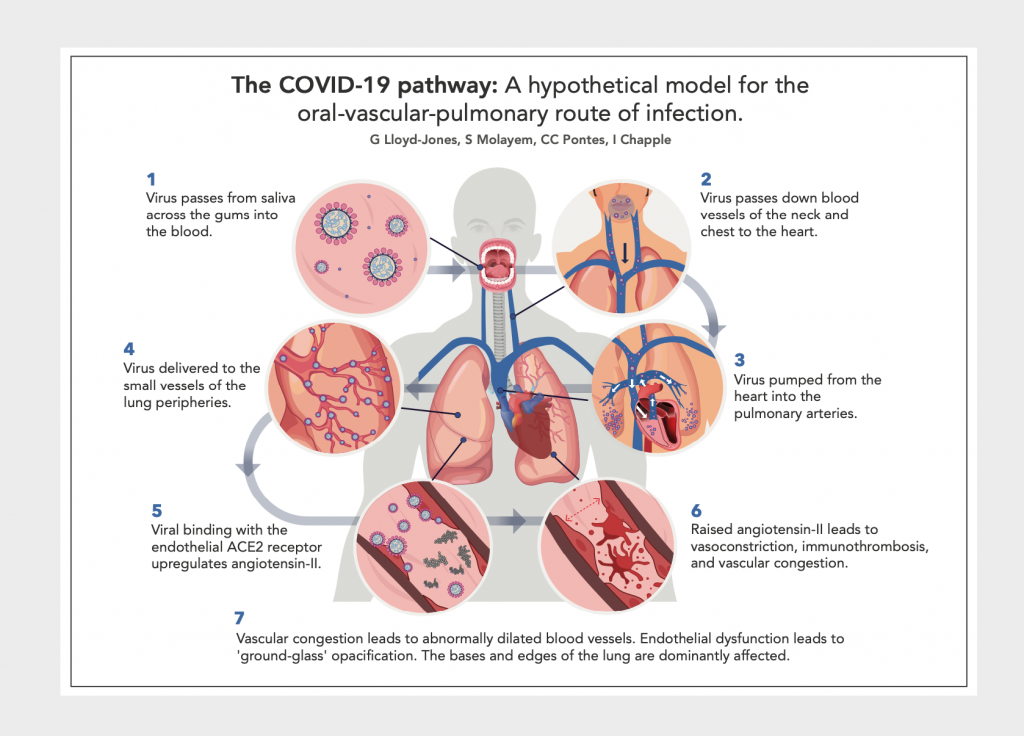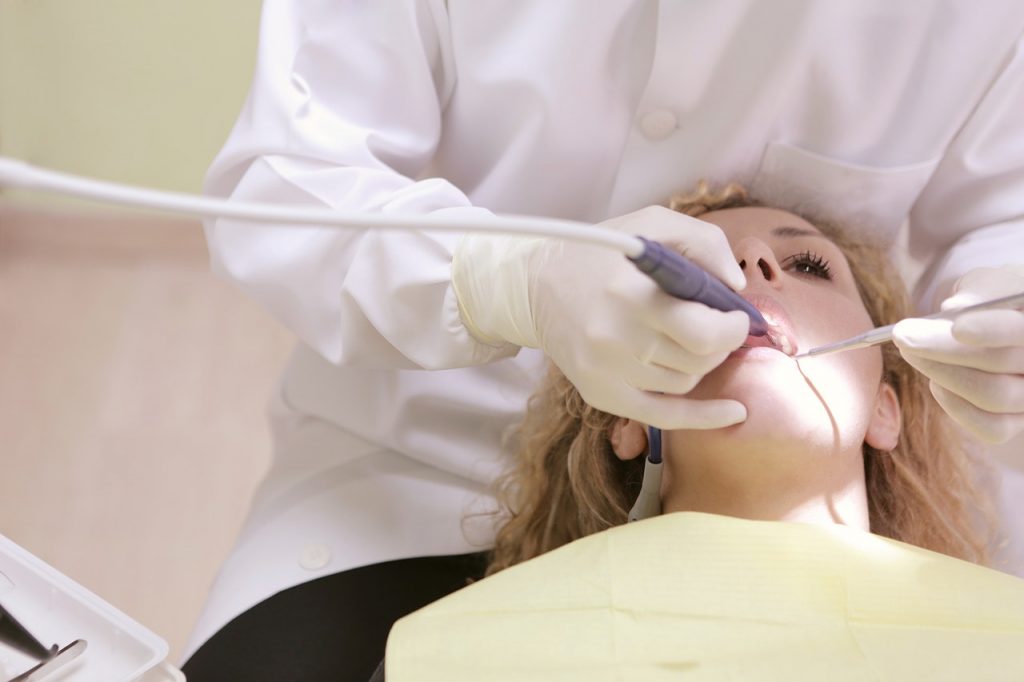Are the Mouth and Gums a Transmission Path for COVID-19? Could Good Oral Health and Mouthwash Reduce Risk?
Just released research, published in Genesis Publications, introduces a new model explaining why gum disease and poor oral hygiene could be a more accurate predictor for COVID-19 severity than patient age,ethnicity, or multiple other risk factors. The paper was led by international team of COVID-19 researchers in the United Kingdom, United States and South Africa. Their theory is that the virus reaches the lungs via the blood, rather than via the airways of the lungs. They say the first step the virus takes on its way to the lungs is through the defense barrier of the gums in the mouth and then enters into the bloodstream.
This new hypothesis challenges the popular notion that the virus enters the body through the airway. Instead it suggests that the mouth and nose are key entry points for the virus. The model proposed in the paper explains the route taken by the virus: from saliva in the mouth, via the gums, into the blood vessels of the neck, and chest, through the heart, and to the lung blood vessels.
- The virus binds to membranes in the nose andmouth, with saliva acting as a reservoir of the virus.
- From the saliva the virus could escape via damaged gums, enter its blood vessels and pass in the bloodstream to the lungs.
- It is the blood vessels which are visibly damaged first on CT scans.
New Model: Mouth and Gums as a Transmission Path for COVID-19

“Given the high viral load found in saliva, this blood-borne route of transfer to the lungs is highly plausible,” said Iain Chapple, PhD, BDS, FDSRCPS, FDSRCS,CCST (RCS) and Director of Research, Institute of Clinical Sciences, College of Medical & Dental Sciences, Periodontal Research Group, The University of Birmingham & Birmingham Community Health Trust, Birmingham, United Kingdom.
Is this just a theory? The authors say that this new research should be considered on a global scale. “Many of the risk factors for severe COVID-19 and gum disease are the same: increased age, male sex, specific ethnic groups, obesity, diabetes, cardiovascular disease, type-A blood group, chronic kidney disease, and those who find it difficult to care for their mouth, for example those with dementia, physical disability or learning difficulties. It could be that gum disease is a converging and principal risk factor for severe COVID-19,” says Dr. Graham Lloyd-Jones, BA, MBBS, MRCP, FRCR, consultant radiologist, Salisbury District Hospital, United Kingdom. fdrector of radiology masterclass.
One of the precipitous events that led to this paper previously published research. “In our article last July, The Mouth-COVID Connection, we explained that gum disease may lead to increased COVID-19 severity, but now we realize the reason could be because the virus was actually entering into the bloodstream from the gums. This is potentially a huge breakthrough because all this time we have been fighting against an enemy in which we assumed was entering the lungs via the airways. A blood-borne route explains the link between gum disease and severity,” said Shervin Molayem DDS, the lead author, and a periodontist, researcher for the Mouth-Body Research Institute, Los Angeles.
Many papers have been published on the role of oral health as a biological marker for inflammatory diseases, such as cardiovascular illnesses. However, this paper sheds light on the role of simple oral hygiene measures and the use of specific publicly available mouthwashes to lower the risk of transmission of the virus from the mouth to the lungs.
“Disrupting the virus reservoir in saliva and addressing oral conditions that favor viral passage to the blood, such as gum disease, might become fundamental steps in the management of COVID-19,” says Carla Pontes, MD. PHD, MsC, DDS, periodontist, Researcher– Mouth-Body Research Institute, CapeTown, South Africa.

The research highlights the importance of good oral hygiene and oral healthcare in the context of the pandemic. Simple oral healthcare measures should be encouraged in the community, hospitals, and nursing homes. Keeping a healthy mouth may lower the risk of inflammation, and potentially lower the risk of developing severe COVID-19.
Furthermore, use of over-the-counter mouthwashes, containing specific ingredients shown to inactivate the virus in vitro, could reduce transmission from the saliva in the mouth via damaged gums to the lungs. Further research is required, but in the meantime, the paper offers recommendations for the interest of researchers in the field of oral health, leaders of population studies, and for the attention of public health officials or governmental advisers.
Specific mouthwash ingredients shown to inactivate the SARS-CoV-2 virus in vitro include:
- 0.05%-0.1%Cetylpyridinium Chloride (CPC): 15 ml for 30 seconds twice a day. In vitro and in vivo studies indicate that mouthwash products containing CPC are able to inactivate SARS-CoV-2. These products are generally considered to be safe, with staining of the tongue and teeth being rarely reported.
- 0.147%Ethyl lauroyl arginate (ELA): 20 ml for 30seconds twice a day. In vitro results suggest virucidal activity of ELA against SARS-CoV-2.
- 0.2%, 0.4% or 0.5% Povidone-Iodine (PVP-I): 10 ml for 30 seconds twice a day. The use of PVP-I is supported by in vitro and in vivo studies.In one clinical trial, the use of 1% PVP-I mouth rinse resulted in temporary thyroid dysfunction in 42% of COVID-19 patients, suggesting that lower concentrations should be preferred. Contraindications: allergy, hyperthyroidism, thyroid dysfunction, pregnancy, lactation,and treatment with radioactive iodine.
Conclusions of the new hypothesis:
- Since the airways do not appear inflamed on CT scans,and the blood vessels appear abnormal, the virus must dominantly reach the lungs through blood vessels.
- In patients with gum disease, the virus could enter through the gum capillaries (small blood vessels) and into systemic circulation, and then be delivered to the lungs.
- The virus replicates in the salivary glands of the mouth, so the mouth is considered the reservoir of the virus.
- Levels of virus in the saliva and overall health of the mouth are predictors for severe disease in those with COVID-19.
- Dental plaque could provide a constant supply of thevirus directly into the blood during illness with COVID-19. Thus, it could be the ongoing delivery of the virus itself via blood vessels which spreads the virus to lungs,leading to poor outcome.
- Studies have shown that some over-the-counter mouthwashes can inactivate the virus.
- It is proposed that simple oral hygiene measures,including use of these mouthwash products and other simple steps, could help lower the risk of passage of the virus from the mouth to the lungs, and help prevent severe COVID-19.
Click Here to Read the Entire Paper, The COVID-19 Pathway: A Proposed Oral-Vascular-Pulmonary Route of SARS-CoV-2 Infection and the Importance of Oral Healthcare Measures.
More studies:
Dr. Lloyd-Jones’ original theory of theoro-vascululo-pulmonary infection route in COVID-19 as published on the Radiology Masterclass website, 20th February 2021.
Dr. Molayem and Dr. Pontes’ previous research on the COVID-19 / mouth connection.
Professor Chapple’s previous research on SARS-COV-2 in oral healthcare professionals.




